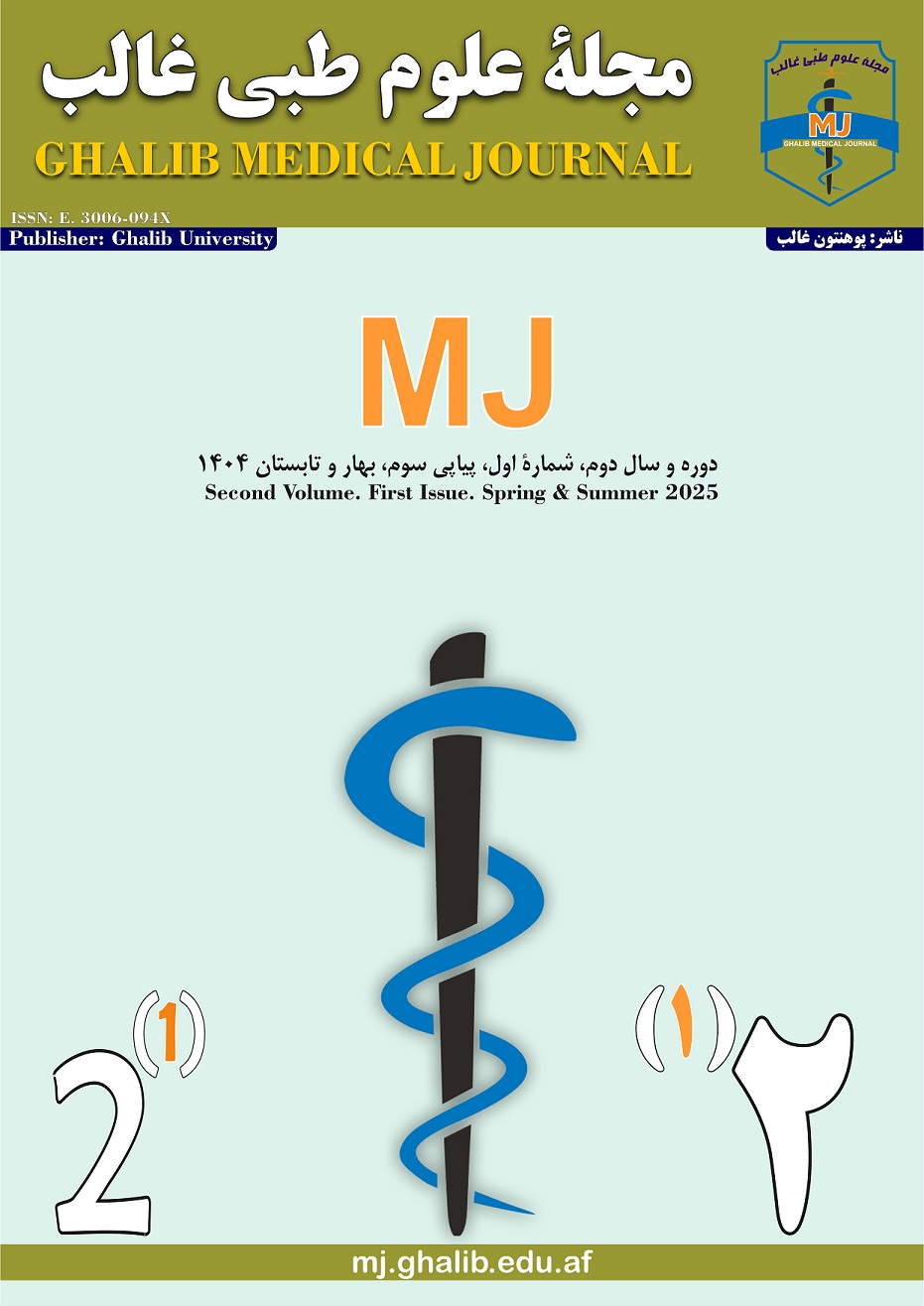رویکردهای بیوشیمیایی اخیر در درمان سرطان: یک مطالعه مروری
DOI::
https://doi.org/10.58342/ghalibMj.V.2.I.1.12کلمات کلیدی:
درمان سرطان, درمان بیوشیمیایی, کریسپر, نانودارو, مهارکنندههای هدفمند, درمانهای RNAچکیده
زمینه و هدف: پیشرفتهای اخیر در حوزه بیوشیمی بهطور چشمگیری چشمانداز درمان سرطان را دگرگون کرده است. روشهای سنتی مانند شیمیدرمانی و پرتودرمانی، با وجود اثربخشی نسبی، اغلب فاقد ویژگیمندی هستند و باعث بروز سمیتهای سیستمیک میشوند. در مقابل، راهکارهای بیوشیمیایی با هدف قرار دادن دقیق مکانیسمهای مولکولی مؤثر در بروز و پیشرفت تومور، درمانهایی هدفمند و کمعارضه ارائه میدهند. این مقاله مروری به بررسی نوآوریهای نوین در درمان بیوشیمیایی سرطان میپردازد؛ با تمرکز بر مکانیسمها، پتانسیل بالینی و چالشهای مرتبط با آنها.
روش بررسی: مطالعهای جامع بر روی مقالات علمی اخیر انجام شد که موضوعاتی مانند مهارکنندههای مولکولی هدفمند، درمانهای آنزیمی، فناوریهای ویرایش ژن نظیر (CRISPR-Cas) ، درمانهای مبتنی بر RNA، بازبرنامهریزی متابولیکی، و سامانههای نانوفناورانه در رسانش دارو را پوشش میدهد.
یافتهها: رویکردهای نوین بیوشیمیایی در درمان سرطان توانستهاند دقت درمانی را افزایش، عوارض جانبی را کاهش، و نتایج درمانی بیماران را بهبود بخشند. بهویژه، ویرایش ژنی مبتنی برCRISPR ، خاموشسازی ژنهای سرطانی با استفاده ازsiRNA و نانوذرات چندکاره برای رسانش هدفمند دارو، افقهای نوینی را در انکولوژی دقیق گشودهاند.
نتیجهگیری: درمانهای بیوشیمیایی در حال تبدیل انکولوژی به دانشی فردمحور و کمتهاجمی هستند. با اینکه چالشهایی نظیر ناهمگونی توموری، محدودیتهای رسانش، اثرات ناخواسته و هزینههای بالا همچنان وجود دارند، پژوهشهای در حال پیشرفت و تلفیق میانرشتهای نویدبخش موفقیتهای بالینی در آینده نزدیک خواهند بود.
مراجع
Porta, C., Paglino, C., & Mosca, A. (2014). Targeting PI3K/Akt/mTOR Signaling in Cancer. Frontiers in Oncology, 4, 64. https://doi.org/10.3389/fonc.2014.00064
Roskoski, R. (2012). ERK1/2 MAP kinases: structure, function, and regulation. Pharmacological Research, 66(2), 105–143. https://doi.org/10.1016/j.phrs.2012.04.005
Vihinen, P., & Kähäri, V. M. (2002). Matrix metalloproteinases in cancer: Prognostic markers and therapeutic targets. International Journal of Cancer, 99(2), 157–166. https://doi.org/10.1002/ijc.10339
Warburg, O. (1956). On the origin of cancer cells. Science, 123(3191), 309–314. https://doi.org/10.1126/science.123.3191.309
Yarden, Y., & Pines, G. (2012). The ERBB network: at last, cancer therapy meets systems biology. Nature Reviews Cancer, 12(8), 553–563. https://doi.org/10.1038/nrc3309
Falkenberg, K. J., & Johnstone, R. W. (2014). Histone deacetylases and their inhibitors in cancer, neurological diseases and immune disorders. Nature Reviews Drug Discovery, 13(9), 673–691. https://doi.org/10.1038/nrd4360
Lord, C. J., & Ashworth, A. (2017). PARP inhibitors: Synthetic lethality in the clinic. Science, 355(6330), 1152–1158. https://doi.org/10.1126/science.aam7344
Senter, P. D., & Springer, C. J. (2001). Selective activation of anticancer prodrugs by monoclonal antibody-enzyme conjugates. Advances in Drug Delivery Reviews, 53(3), 247–264. https://doi.org/10.1016/S0169-409X(01)00203-6
Greco, O., & Dachs, G. U. (2001). Gene directed enzyme prodrug therapy: a review of enzyme/prodrug combinations, tumor-targeting strategies and therapeutic outcomes. Journal of Gene Medicine, 3(6), 299–310. https://doi.org/10.1002/jgm.193
Ganapathy-Kanniappan, S., & Geschwind, J. F. H. (2013). Tumor glycolysis as a target for cancer therapy: progress and prospects. Molecular Cancer, 12, 152. https://doi.org/10.1186/1476-4598-12-152
Xie, H. et al. (2014). LDHA inhibition in human pancreatic cancer cells leads to growth inhibition and enhanced sensitivity to gemcitabine. Oncotarget, 5(20), 8660–8670. https://doi.org/10.18632/oncotarget.2400
Gross, M. I. et al. (2014). Antitumor activity of the glutaminase inhibitor CB-839 in triple-negative breast cancer. Molecular Cancer Therapeutics, 13(4), 890–901. https://doi.org/10.1158/1535-7163.MCT-13-0793
Menendez, J. A., & Lupu, R. (2007). Fatty acid synthase and the lipogenic phenotype in cancer pathogenesis. Nature Reviews Cancer, 7(10), 763–777. https://doi.org/10.1038/nrc2222
Svensson, R. U. et al. (2016). Inhibition of acetyl-CoA carboxylase suppresses fatty acid synthesis and tumor growth. Cancer Cell, 29(6), 807–823. https://doi.org/10.1016/j.ccell.2016.05.002
Stein, E. M. et al. (2017). Enasidenib in mutant IDH2 relapsed or refractory acute myeloid leukemia. Blood, 130(6), 722–731. https://doi.org/10.1182/blood-2017-04-779405
Schröder, F. H. et al. (2009). Screening and prostate-cancer mortality in a randomized European study. New England Journal of Medicine, 360(13), 1320–1328. https://doi.org/10.1056/NEJMoa0810084
Trevisani, F. et al. (2001). Serum alpha-fetoprotein for diagnosis of hepatocellular carcinoma in patients with chronic liver disease: influence of HCV infection and liver disease severity. British Journal of Cancer, 85(6), 818–824. https://doi.org/10.1054/bjoc.2001.1996
Jacobs, I. et al. (1993). A risk of malignancy index incorporating CA 125, ultrasound and menopausal status for the accurate preoperative diagnosis of ovarian cancer. British Journal of Obstetrics and Gynaecology, 100(10), 927–931. https://doi.org/10.1111/j.1471-0528.1993.tb14239.x
Slamon, D. J. et al. (2001). Use of chemotherapy plus a monoclonal antibody against HER2 for metastatic breast cancer that overexpresses HER2. New England Journal of Medicine, 344(11), 783–792. https://doi.org/10.1056/NEJM200103153441101
Karapetis, C. S. et al. (2008). K-ras mutations and benefit from cetuximab in advanced colorectal cancer. New England Journal of Medicine, 359(17), 1757–1765. https://doi.org/10.1056/NEJMoa0804385
Early Breast Cancer Trialists' Collaborative Group (EBCTCG). (2011). Relevance of breast cancer hormone receptors and other factors to the efficacy of adjuvant tamoxifen: patient-level meta-analysis of randomized trials. Lancet, 378(9793), 771–784. https://doi.org/10.1016/S0140-6736(11)60993-8
Garon, E. B. et al. (2015). Pembrolizumab for the treatment of non–small-cell lung cancer. New England Journal of Medicine, 372(21), 2018–2028. https://doi.org/10.1056/NEJMoa1501824
Druker, B. J. et al. (2001). Efficacy and safety of a specific inhibitor of the BCR-ABL tyrosine kinase in chronic myeloid leukemia. New England Journal of Medicine, 344(14), 1031–1037. https://doi.org/10.1056/NEJM200104053441401
Robson, M. et al. (2017). Olaparib for metastatic breast cancer in patients with a germline BRCA mutation. New England Journal of Medicine, 377(6), 523–533. https://doi.org/10.1056/NEJMoa1706450
Bettegowda, C. et al. (2014). Detection of circulating tumor DNA in early- and late-stage human malignancies. Science Translational Medicine, 6(224), 224ra24. https://doi.org/10.1126/scitranslmed.3007094
Zhang, W. et al. (2015). Exosomes in cancer: small particle, big player. Journal of Hematology & Oncology, 8(1), 83. https://doi.org/10.1186/s13045-015-0181-x
Lu, Y. et al. (2020). Safety and feasibility of CRISPR-edited T cells in patients with refractory non-small-cell lung cancer. Nature Medicine, 26(5), 732–740. https://doi.org/10.1038/s41591-020-0840-5
Liu, Y. et al. (2019). CRISPR/Cas9-mediated gene editing of KRAS in colorectal cancer cells inhibits tumor growth. Biochemical and Biophysical Research Communications, 548, 85–92. https://doi.org/10.1016/j.bbrc.2021.07.010
Li, J. et al. (2017). Targeting BRAF mutations in melanoma using CRISPR-Cas9. Cancer Letters, 395, 19–26. https://doi.org/10.1016/j.canlet.2017.02.015
Haapaniemi, E. et al. (2018). CRISPR–Cas9 genome editing induces a p53-mediated DNA damage response. Nature Medicine, 24(7), 927–930. https://doi.org/10.1038/s41591-018-0049-z
Jinek, M. et al. (2012). A programmable dual-RNA-guided DNA endonuclease in adaptive bacterial immunity. Science, 337(6096), 816–821. https://doi.org/10.1126/science.1225829
Shalem, O. et al. (2014). Genome-scale CRISPR-Cas9 knockout screening in human cells. Science, 343(6166), 84–87. https://doi.org/10.1126/science.1247005
Lino, C. A. et al. (2018). Delivering CRISPR: a review of the challenges and approaches. Drug Delivery, 25(1), 1234–1257. https://doi.org/10.1080/10717544.2018.1474964
Barenholz, Y. (2012). Doxil®—the first FDA-approved nano-drug: lessons learned. Journal of Controlled Release, 160(2), 117–134. https://doi.org/10.1016/j.jconrel.2012.03.020
Allen, T. M., & Cullis, P. R. (2013). Liposomal drug delivery systems: from concept to clinical applications. Advanced Drug Delivery Reviews, 65(1), 36–48. https://doi.org/10.1016/j.addr.2012.09.037
Danhier, F. et al. (2012). PLGA-based nanoparticles: an overview of biomedical applications. Journal of Controlled Release, 161(2), 505–522. https://doi.org/10.1016/j.jconrel.2012.01.043
Govender, T. et al. (2000). PLGA nanoparticles for drug delivery: a review of recent advances. Critical Reviews in Therapeutic Drug Carrier Systems, 17(2), 137–185.
Dreaden, E. C. et al. (2012). The golden age: gold nanoparticles for biomedicine. Chemical Society Reviews, 41(7), 2740–2779. https://doi.org/10.1039/C1CS15237H
Laurent, S. et al. (2011). Magnetic iron oxide nanoparticles: synthesis, stabilization, vectorization, physicochemical characterizations, and biological applications. Chemical Reviews, 111(9), 7783–7813. https://doi.org/10.1021/cr200379h
Ramasamy, T. et al. (2014). Smart polymeric nanoplatforms for cancer therapy: recent advances and future perspectives. Acta Pharmaceutica Sinica B, 4(3), 197–217. https://doi.org/10.1016/j.apsb.2014.04.005
Needham, D. et al. (2000). Temperature-sensitive liposomes for the delivery of doxorubicin: clinical implications. Advanced Drug Delivery Reviews, 53(3), 285–305. https://doi.org/10.1016/S0169-409X(01)00234-7
Vader, P. et al. (2016). Extracellular vesicles for drug delivery. Advanced Drug Delivery Reviews, 106, 148–156. https://doi.org/10.1016/j.addr.2016.02.006
Verma, S. et al. (2012). Trastuzumab emtansine for HER2-positive advanced breast cancer. New England Journal of Medicine, 367(19), 1783–1791. https://doi.org/10.1056/NEJMoa1209124
Dagogo-Jack, I. & Shaw, A. T. (2018). Tumor heterogeneity and resistance to cancer therapies. Nature Reviews Clinical Oncology, 15(2), 81–94. https://doi.org/10.1038/nrclinonc.2017.166
Blanco, E. et al. (2015). Principles of nanoparticle design for overcoming biological barriers to drug delivery. Nature Biotechnology, 33(9), 941–951. https://doi.org/10.1038/nbt.3330
Charlesworth, C. T. et al. (2019). Identification of preexisting adaptive immunity to Cas9 proteins in humans. Nature Medicine, 25(2), 249–254. https://doi.org/10.1038/s41591-018-0326-x
Prasad, V. et al. (2018). The high price of anticancer drugs: origins, implications, barriers, solutions. Nature Reviews Clinical Oncology, 15(6), 381–394. https://doi.org/10.1038/s41571-018-0007-z
Hood, L. & Friend, S. H. (2011). Predictive, personalized, preventive, participatory (P4) cancer medicine. Nature Reviews Clinical Oncology, 8(3), 184–187. https://doi.org/10.1038/nrclinonc.2010.227
Ogretmen B. Sphingolipid metabolism in cancer signalling and therapy. Nature Reviews Cancer. 2018;18(1):33–50. https://doi.org/10.1038/nrc.2017.96
Saddoughi SA, Ogretmen B. Diverse functions of ceramide in cancer cell death and proliferation. Advances in Cancer Research. 2020;148:1–39. https://doi.org/10.1016/bs.acr.2020.04.002
Pyne NJ, Pyne S. Sphingosine 1-phosphate and cancer. Nature Reviews Cancer. 2022;22(6):346–361. https://doi.org/10.1038/s41568-022-00453-6
##submission.downloads##
چاپ شده
ارجاع به مقاله
شماره
نوع مقاله
مجوز
حق نشر 2025 نصیراحمد ابراهیمی, خواجه جمیل احمد جامی, محمداحسان صالحی

این پروژه تحت مجوز بین المللی Creative Commons Attribution 4.0 می باشد.










